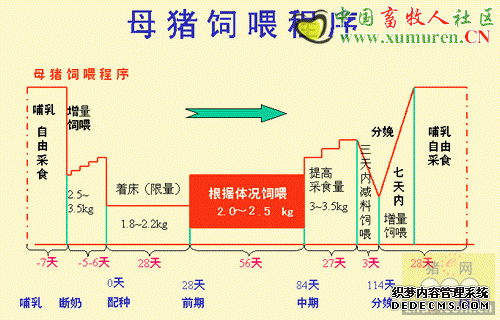Feed Intake - A Checklist of Nutritional, Environmental and Management Strategies to Achieve Success
By D. L. Whittington, C.M. Nyachoti, J.F. Patience, H. W. Gonyou1, R.T. Zijlstra1 and S.P. Lemay. Feed Intake (FI) is among the most elusive of challenges stockpeople face to monitor and influence. This production-limiting problem is multi-faceted, farm specific, and time consuming to obtain measurable results.
Introduction
Feed intake is key to developing diet specifications, attainingtarget growth rates and has a significant impact on efficiency of production.Surveys have shown that feed intake varies by at least 25 percent among commercial farms.
This may in fact under-estimate the problem, since accurate data on feed intake is not readily available on many farms. Some of the data that is available, if estimated from long-term averages, or calculated on an inventory basis, fail to identify short-term deviations from this average.
Feed intake, viewed as a continuum from birth through marketing, is best described by acurvilinear function. It is not a straight line. That is why they are referred to as growth 揷urves.?
While total feed intake for a given group of pigs, calculated over the total growout period, provides a useful reference point against which other groups of pigs can be compared, it fails to generate the time course of feed consumption, which is essential to precise diet formulation. The three feed intake curves, illustrated in Figure 1, demonstrate the point very well.
The curve labelled 揊arm A?represents the 搕heoretical?feed intake of a group of pigs from 20 through 115 kg, as predicted by NRC (1987), assuming a dietary DE content of 3.3 Mcal/kg. The other two curves result in identical overall feed consumption, but obviously arrive there in different ways.
Farm B achieved outstanding feed intake during the early to mid growout period, butsuffered a serious drop in intake during the finishing period. Clearly, a lost opportunity exists here, as the loss in intake experienced late in life negates possible gains earlierin growout.
On the other hand, Farm C experiences a lower intake during initial growout, but achieves excellent intakes later on. Average daily feed intake, calculated for the complete growout period, would result in the conclusion that these three herds are all experiencing equivalent performance in terms of feed intake, when this is clearly not the case.
Figure 1: Three feed intake curves which all
result in the same total feed intake for the period
Turning to Figure 2, we see two actual feed intake curves, generated on two commercial farms during the same season. The NRC 搒tandard?is presented as a reference. Farm A experiences problems with feed intake during the initial grower period, but once the pigs enter the finishing barn, feed intake accelerates and exceeds NRC by a considerablemargin, something which is not normally observed in commercial practice.
Farm B experiences feed intake which is consistently below NRC, and in fact, is not toodissimilar from what is often observed on many confinement units. Again, the advantage of having completed feed intake curves is illustrated, because it focused attention on where shortfalls occur, and thus made diagnosing the problem so much easier.
Once feed intake has been identified as a problem, the next step, obviously, is to resolve it. Where does one look and what does one do to assist farm clients in overcoming shortfalls in feed intake?
Figure 2: Two feed intake curves determined on
commercial farms, with NRC presented for reference
Feed intake is influenced by genetics 揟he intensive selection programs for pig genotypes with better feed efficiency (FE) and carcass leanness have inadvertently selected pigs with reduced voluntary feed intake?(Webb,1989). Consequently, on most commercial swine farms, adequate feed intake is hardly realized and this is now generally recognized as a major factor limiting production.
Feed intake in pigs is also influenced by a number of factors related to the environment, management practices, as well as the pig itself. This means that a clear understanding of the key factors involved in determining voluntary FI in pigs is an important prerequisite for designing diets to ensure adequate nutrient intake under different production systems. Such information will also make it possible to impose nutrient intake restriction when desired.
The effects of many of the factors affecting voluntary FI in pigs have been previously measured. Most of these data have been derived from smaller studies often involving small groups or individually housed pigs and designed to evaluate a single factor at a time.
声明
来源:互联网
本文地址:http://farm.00-net.com/yz/zhu/5/2007-09-20/142401.html








